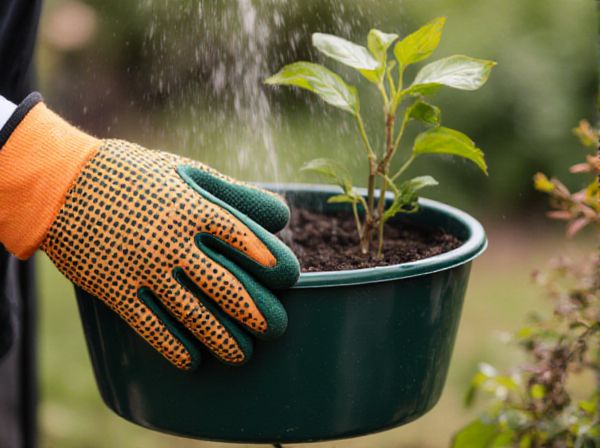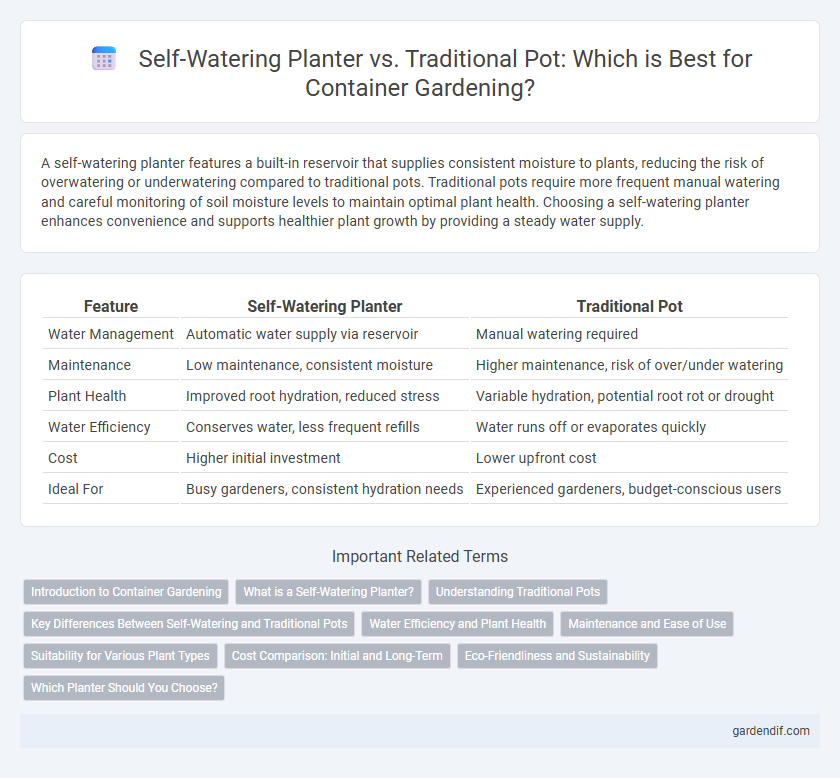
Self-Watering Planter vs Traditional Pot Illustration
A self-watering planter features a built-in reservoir that supplies consistent moisture to plants, reducing the risk of overwatering or underwatering compared to traditional pots. Traditional pots require more frequent manual watering and careful monitoring of soil moisture levels to maintain optimal plant health. Choosing a self-watering planter enhances convenience and supports healthier plant growth by providing a steady water supply.
Table of Comparison
| Feature | Self-Watering Planter | Traditional Pot |
|---|---|---|
| Water Management | Automatic water supply via reservoir | Manual watering required |
| Maintenance | Low maintenance, consistent moisture | Higher maintenance, risk of over/under watering |
| Plant Health | Improved root hydration, reduced stress | Variable hydration, potential root rot or drought |
| Water Efficiency | Conserves water, less frequent refills | Water runs off or evaporates quickly |
| Cost | Higher initial investment | Lower upfront cost |
| Ideal For | Busy gardeners, consistent hydration needs | Experienced gardeners, budget-conscious users |
Introduction to Container Gardening
Self-watering planters enhance container gardening by providing consistent moisture through an integrated reservoir, reducing water stress and promoting healthier plant growth. Traditional pots require frequent watering and careful monitoring to avoid over- or under-watering, which can hinder plant development. Choosing self-watering containers streamlines maintenance and supports thriving plants in diverse indoor and outdoor gardening environments.
What is a Self-Watering Planter?
A self-watering planter features a built-in reservoir that supplies water directly to plant roots through capillary action, reducing the need for frequent watering. This system maintains consistent soil moisture levels, promoting healthier plant growth compared to traditional pots that require manual watering and often risk over- or under-watering. Ideal for busy gardeners, self-watering planters optimize water usage and enhance plant hydration efficiency.
Understanding Traditional Pots
Traditional pots are typically made from materials like terracotta, ceramic, or plastic, which do not regulate moisture, requiring frequent manual watering to keep plants healthy. These pots rely on drainage holes to prevent waterlogging, making it essential for growers to monitor watering schedules closely. Unlike self-watering planters, traditional pots depend entirely on the gardener's attention to soil moisture levels, impacting plant growth and maintenance.
Key Differences Between Self-Watering and Traditional Pots
Self-watering planters feature an integrated water reservoir that provides consistent moisture to plants, reducing the risk of overwatering and underwatering common in traditional pots. Traditional pots rely on manual watering, requiring more frequent attention and often leading to uneven soil moisture levels. The self-watering design promotes healthier root growth and conserves water, making it efficient for both indoor and outdoor gardening.
Water Efficiency and Plant Health
Self-watering planters utilize a built-in reservoir that delivers consistent moisture directly to plant roots, reducing water waste by up to 50% compared to traditional pots with top watering methods. This system promotes healthier root growth and prevents overwatering or underwatering, common issues with standard containers. By maintaining optimal soil moisture levels, self-watering containers enhance plant vigor and reduce the frequency of irrigation needed.
Maintenance and Ease of Use
Self-watering planters significantly reduce maintenance by providing a consistent water supply through a built-in reservoir, minimizing the risk of overwatering or underwatering. Traditional pots require frequent manual watering and more attention to soil moisture levels, increasing the possibility of plant stress due to irregular care. The ease of use in self-watering planters makes them ideal for busy individuals or beginners, as they extend watering intervals and simplify plant care routines.
Suitability for Various Plant Types
Self-watering planters provide consistent moisture levels, making them ideal for moisture-loving plants such as herbs, ferns, and tropical species, which require steady hydration. Traditional pots suit a wider variety of plants, especially those prone to root rot or those that demand well-drained soil, like succulents and cacti, as they allow better control over watering frequency. Selecting between these containers depends on plant type, soil moisture needs, and the gardener's ability to monitor watering schedules.
Cost Comparison: Initial and Long-Term
Self-watering planters generally have a higher initial cost, ranging from $20 to $50, compared to traditional pots, which can be purchased for as low as $5 to $20. Over time, self-watering containers reduce maintenance expenses by conserving water and minimizing plant loss due to inconsistent watering, resulting in lower long-term costs. Traditional pots may require additional investment in watering tools and more frequent plant replacements, increasing overall expenditure.
Eco-Friendliness and Sustainability
Self-watering planters reduce water waste by delivering moisture directly to plant roots, promoting efficient water use and minimizing runoff compared to traditional pots. They support sustainability through decreased frequency of watering, conserving natural resources and reducing energy consumption related to irrigation. Unlike traditional pots that may require frequent watering and can lead to overwatering or underwatering, self-watering systems enhance plant health while lowering environmental impact.
Which Planter Should You Choose?
Self-watering planters maintain consistent moisture by slowly releasing water to plant roots, reducing the risk of overwatering and promoting healthier growth, especially for busy gardeners or those in hot climates. Traditional pots require manual watering, offering greater control but increasing the chance of inconsistent moisture levels that can stress plants. Choose a self-watering planter for convenience and optimal hydration or a traditional pot if you prefer precise watering control and simple design.
Self-Watering Planter vs Traditional Pot Infographic

 gardendif.com
gardendif.com